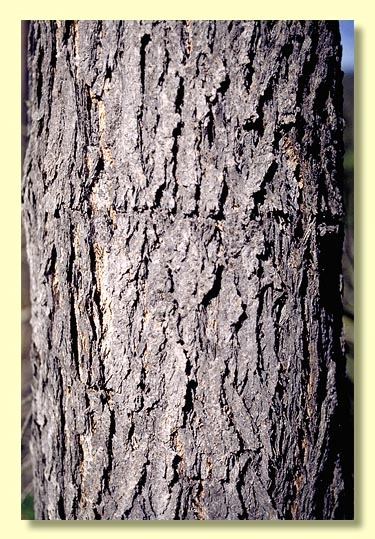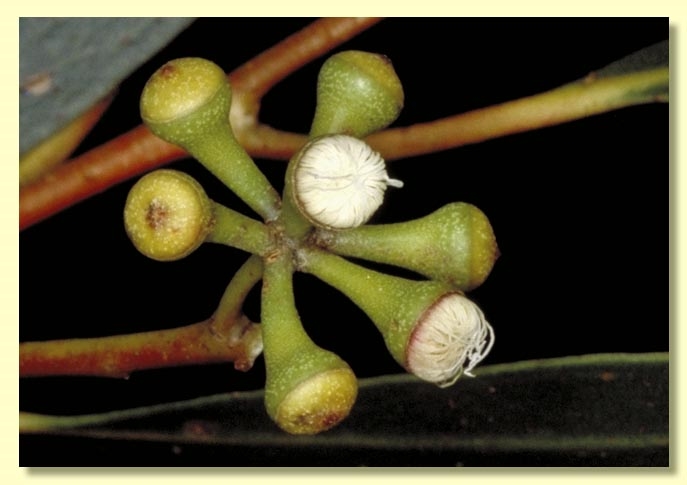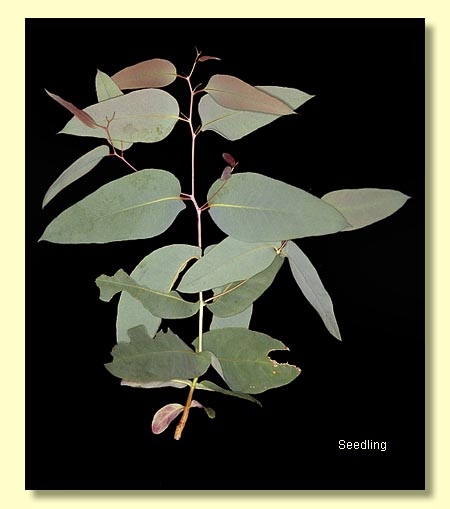Euclid - Online edition
Eucalyptus sieberi
Eucalyptus | Eucalyptus | Cineraceae | Psathyroxylon | Considenianae
T: Blackheath, NSW, Apr. 1899, J.H.Maiden s.n.; holo: NSW.
Eucalyptus sieberiana F.Muell., Eucalyptographia Decade 2: 9th plate (1879), nom. illeg. based on E. virgata Sieber ex Sprengel p.p.
Bark rough on trunk and base of large branches, at first thin, flaky and orange-brown, becoming compact, thick, longitudinally furrowed and dark grey to black as trees age; smooth bark sometimes powdery, white to cream or yellow; branchlets sometimes glaucous.
Juvenile growth (coppice or field seedlings to 50 cm): stem rounded in cross-section, glaucous; juvenile leaves sessile and opposite for a few pairs then alternate, ovate to lanceolate to falcate, 6–17 cm long, 1.6–7.5 cm wide, blue-green to glaucous.
Adult leaves alternate, petiole 1–2 cm long; blade lanceolate to falcate, 8.5–19.5 cm long, 1.2–3.8 cm wide, base oblique or tapering to petiole, concolorous, glossy, green, side-veins acute to almost parallel, reticulation obscure or sparse, intramarginal vein parallel to and just within margin or well removed from it, oil glands mostly island.
Inflorescence axillary unbranched, peduncles 0.8–1.6 cm long, buds 7 to 15 per umbel, pedicels 0.3–0.7 cm long. Mature buds obovoid or clavate, 0.3–0.5 cm long, 0.3–0.4 cm wide, green, smooth or slightly warty, scar absent, operculum rounded or flattened, stamens inflexed, with outer staminodes, anthers reniform to cordate, versatile, dorsifixed, dehiscing by confluent slits, style short, stigma blunt or tapered, locules 3 each with 2 vertical ovule rows. Flowers white.
Fruit on pedicels 0.1–0.4 cm long, barrel-shaped or obconical, 0.6–1.1 cm long, 0.6–0.9 cm wide, disc slightly raised to level or slightly descending, valves 3, near rim level or enclosed.
Seeds black, brown or grey, 1–3 mm long, pyramidal or obliquely pyramidal, dorsal surface smooth, hilum terminal.
Cultivated seedlings (measured at ca node 10): cotyledons reniform; stems rounded in cross-section, usually glaucous; leaves opposite, sessile, elliptic, amplexicaul and discolorous for ca 4 to 8 nodes then alternate, shortly petiolate, ovate-lanceolate, 6–13 cm long, 2–5.5 cm wide, base rounded to tapering, margin entire, apex pointed, becoming concolorous, blue-green to grey-green.
Flowering has been recorded in January, July, August, October and November.
A medium-sized to tall forest tree widespread in south-eastern Australia. In New South Wales from the Watagan Range west of Wyong south to the Eden area where abundant, and also further inland on the Central and Southern Tablelands as far west as near Tharwa in the Australian Capital Territory. Also widespread in eastern Victoria south and east of the Great Dividing Range with an extension west of Melbourne in the Pyrete Range near Gisborne. In north-east Tasmania it occurs from St Helens to Fingal Valley and Freycinet Peninsula. Eucalyptus sieberi is a component of dry sclerophyll forest usually on impoverished sandy and gravelly soils.
Eucalyptus sieberi is distinguished by the bark of the larger saplings which is flaky, grey-brown over orange and the mature rough bark which is thick, compact, fissured, grey-black over the whole trunk rather like "ironbark". Adult leaves are glossy green with very acute side-veins, buds club-shaped in clusters of seven to 15, and fruit obconical to barrel-shaped and three-valved. Juvenile growth and young saplings are glaucous-stemmed and in contrast with the usually non-glaucous young growth of the closely related E. consideniana, which has finely fibrous peppermint bark and fruit with four valves. Other rough-barked species with which E. sieberi grows differ in having obviously fibrous "stringybark" or flaky "box" type bark. Other true "ironbark" species occurring within the natural range of E. sieberi all have dark grey to black furrowed bark extending to the smaller limbs whereas E. sieberi has conspicuous smooth white branches giving it the common name "Silvertop".
Eucalyptus sieberi belongs in Eucalyptus subgenus Eucalyptus section Cineraceae series Psathyroxylon having the following characters: cotyledons reniform, juvenile leaves alternate, bluish, adult leaves with side-veins acute, single axillary inflorescences with buds in clusters of seven to 15, buds with single operculum, inflexed stamens, some outer stamens without anthers (staminodes), the remainder with reniform anthers, style short, ovules in two rows, and seeds more or less pyramidal. Within series Psathyroxylon, E. sieberi is closely related to E. andrewsii, E. consideniana, E. remota, E. olida and E. multicaulis, differing from all in bark characteristics. These six species form subseries Considenianae.













